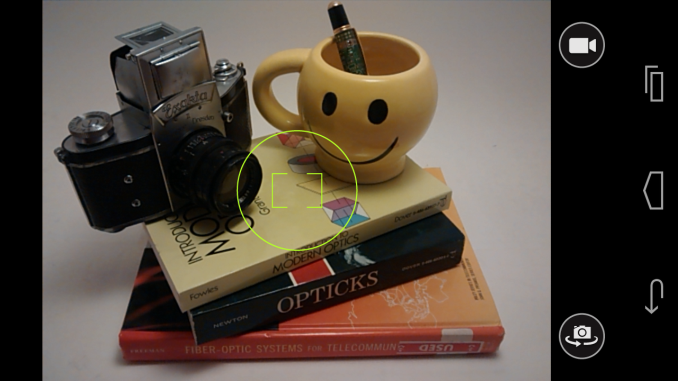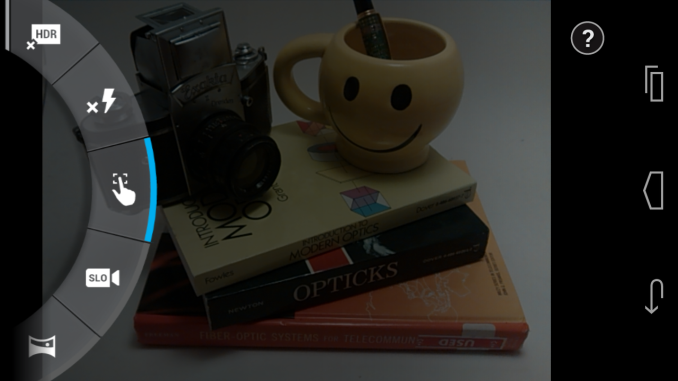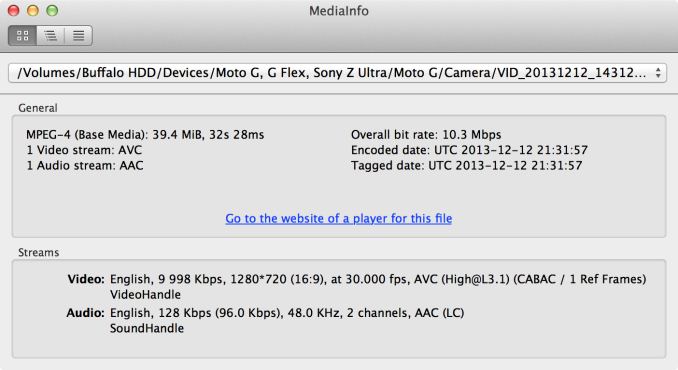Motorola Moto G Review
by Brian Klug on December 18, 2013 2:00 PM EST- Posted in
- Smartphones
- Motorola
- Mobile
- *VA
- Cortex A7
- snapdragon 400
- Moto G
On the camera side the Moto G includes a 5 MP rear facing camera with autofocus and LED flash, on the front it includes a 1.3 MP camera. I did some digging and found that the rear facing camera CMOS is an Aptina AR0543 CMOS. There’s nothing on Aptina’s website about the AR0543, but there is an AR0542 which probably is its predecessor with 1/4 Inch format and 1.4 μm pixels. I suspect this is exactly the form factor of the sensor in Moto G, with some slight improvements, I believe the color filter array is Bayer as well, not RGBW like Moto X. The rear facing camera module has a focal length of 3.5 mm which works out to around a 37mm focal length in 35mm-equivalent units, the system has an F/# of 2.4, which is great for a device of this cost.
On the front is the Aptina MT9M114 1.3 MP, 1/6 Inch with 1.9 µm pixels sensor that we’ve seen a lot of in recent days.
Motorola uses the same camera application as the Moto X, and reflects the most recent UI changes that have rolled out in both OTAs and through the Play Store. The biggest change is a new spot focus and exposure point which can be dragged around the live preview. Motorola calls it manual focus and exposure, in practice it’s really a weighted spot meter and focus point that you can drag around. I’d only call what LG has on the G2 or Nokia bundles as manual focus, but the new camera app is a substantial improvement over the UI as it launched with the Moto X, which didn’t afford any exposure or metering controls (instead taking a scene average), only tap to focus, which ran a full AF search wherever you tapped.
The camera settings menu still is a ring chooser that slides out with a drag from the left side, and has settings for HDR, flash, tap to focus/expose, slow motion video, panorama, location, a new aspect ratio toggle (16:9 and 4:3) and shutter sound. The aspect ratio toggle is what’s new versus the X, since the Moto G has a standard 4:3 aspect ratio sensor and not the 16:9 aspect ratio aspect ratio of the Moto X. By default the Moto G launches with the 16:9 aspect ratio for image capture, cropping off part of the image area, but tapping 4:3 gives you a proper live, full field of view, 4:3 preview. Major kudos to Motorola for giving an aspect-correct live preview. Shot to shot latency is longer than Moto X or other flagships, but not inordinately long or on the order of seconds. I should note that the Moto G does not include the same wrist-flick camera activation gesture as the Moto X.
To evaluate image quality we turn to the usual combination of photos taken at the bench locations, although location 7 wasn’t available, and photo tests in a lightbox with lights on, and off, and of test charts. I also continue to take photos while out and about with devices to get samples in a variety of other conditions.
Moto G still image quality is better than I had suspected. Outdoors in well lit scenes the Moto G is totally capable of delivering good quality shots with good exposure and focus.
My only major criticism is that there’s definitely some off-axis loss of sharpness, the leftmost part of almost every image gets blurry quickly, the right side doesn’t show nearly as much. Alignment tolerances for smartphone optics are a part of module cost, I wouldn’t be surprised to see variance like this. In low light or indoors, the Moto G occasionally struggles to produce images without blur, but that’s a complaint I still levy against some modern flagships. There’s also a bit of light leakage on the Moto G which crops up when outdoors, but nothing crazy. Front facing camera quality is totally par with other flagships I’ve tried, which isn’t surprising.
Camera - Video
On the video side, the Moto G’s interface is, no surprise, just like the Moto X. There’s a video button that immediately starts video capture, successive taps in the image area capture still frames from the live video. Although MSM8x26 supports up to 1080p30 video encode for H.264, Moto G oddly enough captures video at 720p30 in H.264 High profile at 10 Mbps. Audio is stereo thankfully at 128 kbps AAC.
As always I’ve uploaded a copy of the video recorded at the usual place to YouTube and to our servers for you to look at without the additional compression.
Video from the Moto G is well exposed and appears great for being 720p. I would personally miss 1080p, but the Moto G seems great for the resolution it affords. There’s no dropped frames or visible macroblocking, and exposure seems good, again my only desire would be for 1080p resolution.























































120 Comments
View All Comments
makken - Wednesday, December 18, 2013 - link
" LG was arguably first to lay claim to it with its Optimus G, G Pro, G2, and now G Flex brands"Are we not counting the HTC G1 and G2 now? :(
blanarahul - Wednesday, December 18, 2013 - link
Htc is almost dead. I hope Lg buys them. That will give Samsung a run for their money.blanarahul - Wednesday, December 18, 2013 - link
Great review though. Although buying Moto in my country is just as good as buying a Chinese cellphone. There just aren't service centers around here.Flunk - Wednesday, December 18, 2013 - link
The do have service centers for other brands? You're a lucky guy, we need to ship our phones back to god knows where for service. My buddy's Samsung phone ended up in Korea for service.blanarahul - Wednesday, December 18, 2013 - link
I have only used Nokia, Sony and Samsung customer service. But I believe LG has good customer service too. I live in India. Sending to Korea would be a big pain in the ass.spencersears - Friday, October 3, 2014 - link
Motorola Moto G is a fantastic phone, I'd say only HTC One M8 could match up to it (see http://www.consumertop.com/best-phone-guide/). I don't think you'll need much of a service center though (I've not heard anyone who's had trouble with it), but the choice is yours.puremind - Thursday, December 19, 2013 - link
HTC has no reason to be dead any time soon. Like Apple, they will increasingly have to Focus on the premium market Segment (though for different reasons). HTC's supplier Rating and lack of Advertising Budget is the only reason they cannot compete well with Samsung, LG and Sony for the lower and mid range, but they will continue to produce superb devices for the top tier consumer segment.Nagorak - Tuesday, December 24, 2013 - link
They just reported their first loss ever. If they don't turn things around and keep losing money then that is the reason they'll be dead. Companies don't exist to lose money.BallGum - Saturday, December 28, 2013 - link
Yeah, it's quite a shame this is happening. The HTC One is a brilliant phone but despite everything they're just losing sales to Samsung. It's startling how they slipped from being where Samsung is now, but them consider Nokia...jasonelmore - Thursday, January 2, 2014 - link
It doesn't make financial sense to buy them unless they have tons of patents which are valuable to LG,